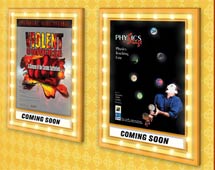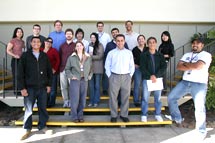Public Lecture Tonight: Dark Energy, What the... ?
Image courtesy of SLAC InfoMedia.
by Kelen Tuttle and Risa Wechsler
In tonight's public lecture, Kavli Institute of Particle Astrophysics and Cosmology researcher Risa Wechsler will discuss the longstanding question, "What is the Universe made of?" According to Wechsler, astronomers and physicists are finally converging on an answer.
The picture which has emerged from numerous complementary observations over the past decade is a surprising one: most of the matter in the universe isn't visible, and most of the universe isn't even made of matter.
At 7:30 p.m. tonight in Panofsky Auditorium, Wechsler will explain what the rest of this stuff, known as "dark
energy" is, how it is related to "dark matter," how it impacts the evolution of the
universe, and how we can study the dark universe using observations of light from current and future telescopes.
Learn more...
|
symmetry:
The Art of the Unseen
by Ken Kingery

Physics posters from around the world. They’d look right at home in a movie theater: A retro, hand-painted Godzilla stomps through blazing rubble amid swarms of airplanes. A woman throws her head back and screams as malevolent birds watch from a gnarled tree. A boxy cartoon robot casts an ominous shadow.
For all their B-movie flair, these posters go beyond mere entertainment. They advertise talks on serious scientific topics at SLAC. Godzilla represents political attacks on science; the screaming woman, the dangers of avian flu; and the robot, the long reach of advancing technologies.
"It's a lot of fun," says Terry Anderson, head graphic designer with SLAC's InfoMedia Solutions group, whose posters have become a cherished part of lab culture. "I get to play Hollywood for a little while."
Posters are a tradition in particle physics, a way of announcing conferences, workshops, and other events that bring the community together. Over the past 25 years they have evolved from pen-and-ink drawings, laboriously produced and printed, to eye-popping computer graphics that can be turned out in a matter of hours. Once available only through the mail, posters can now be downloaded from the Internet.
The role of graphic artists at high-energy physics labs has also changed. Two decades ago, they might have spent 90 percent of their time creating charts and figures for scientific papers and conference presentations. Now that scientists can do much of that work themselves with the aid of graphics software, artists are free to pour their energies into other areas, such as interpreting physics for the public.
"People in the world of physics are used to the blurred boundaries that separate what you can actually see and what you can envision in your mind’s eye," Anderson says. "The result is a large range of possibilities that any artist would love to explore."
Read more...
|
SLAC Welcomes
New Employees
by Kelen Tuttle

Image courtesy of Diana Rogers.
(Click on image for larger version.) SLAC welcomed 18 new employees last week at orientation. A warm welcome to:
Maria Aguaristi,
James Chiang,
Emad Hamrah,
Philip Hart,
Winnie Lam,
Paul Montanez, Homer Neal,
Amanda Sabourov,
Theodore Shab,
Jeffrey Smith,
Joachim Vollaire,
Veronique Ziegler,
Natalya Brown,
Ruben Curiel, James McEntee,
Lu Li and
Melissa Lim.
Gene Bailard attended orientation but is not pictured.
McCallum-Turner: Integrated Performance Management
by Ken Kingery
Integrated Performance Management (IPM) is the focus of this, the eighth SLAC Today article defining McCallum-Turner's 11 focus areas. McCallum-Turner hopes to receive comments and suggestions from everyone at the lab regarding SLAC's management and operations systems focus areas.
IPM can be summed up by two words: planning and implementation. The planning aspect concerns the long-term vision and mission of the entire lab. Implementation is how these plans are then integrated throughout the entire organization.
"The focus will be on the clarity and comprehensiveness of SLAC's vision, mission, planning, and how it is integrated across the lab," said Keith Hodgson, the McCallum-Turner IPM point of contact. "We will research how these plans flow down throughout SLAC and how they are used in making judgments. "We have plans to guide what we do and how we make decisions. The bottom line is how well we create and use them."
McCallum-Turner can by contacted with any ideas, comments or suggestions on
IPM or any of the
other focus areas via e-mail at
mccallum.turner@slac.stanford.edu or by phone at 926-6200.
|

Lab Announcements
Community Bulletin Board
|




 <%
Response.AddHeader "Last-modified", getArticleDate()
'Response.AddHeader "Last-modified","Mon, 01 Sep 1997 01:03:33 GMT"
'Monday, December 06, 2010
%>
<%
Response.AddHeader "Last-modified", getArticleDate()
'Response.AddHeader "Last-modified","Mon, 01 Sep 1997 01:03:33 GMT"
'Monday, December 06, 2010
%>